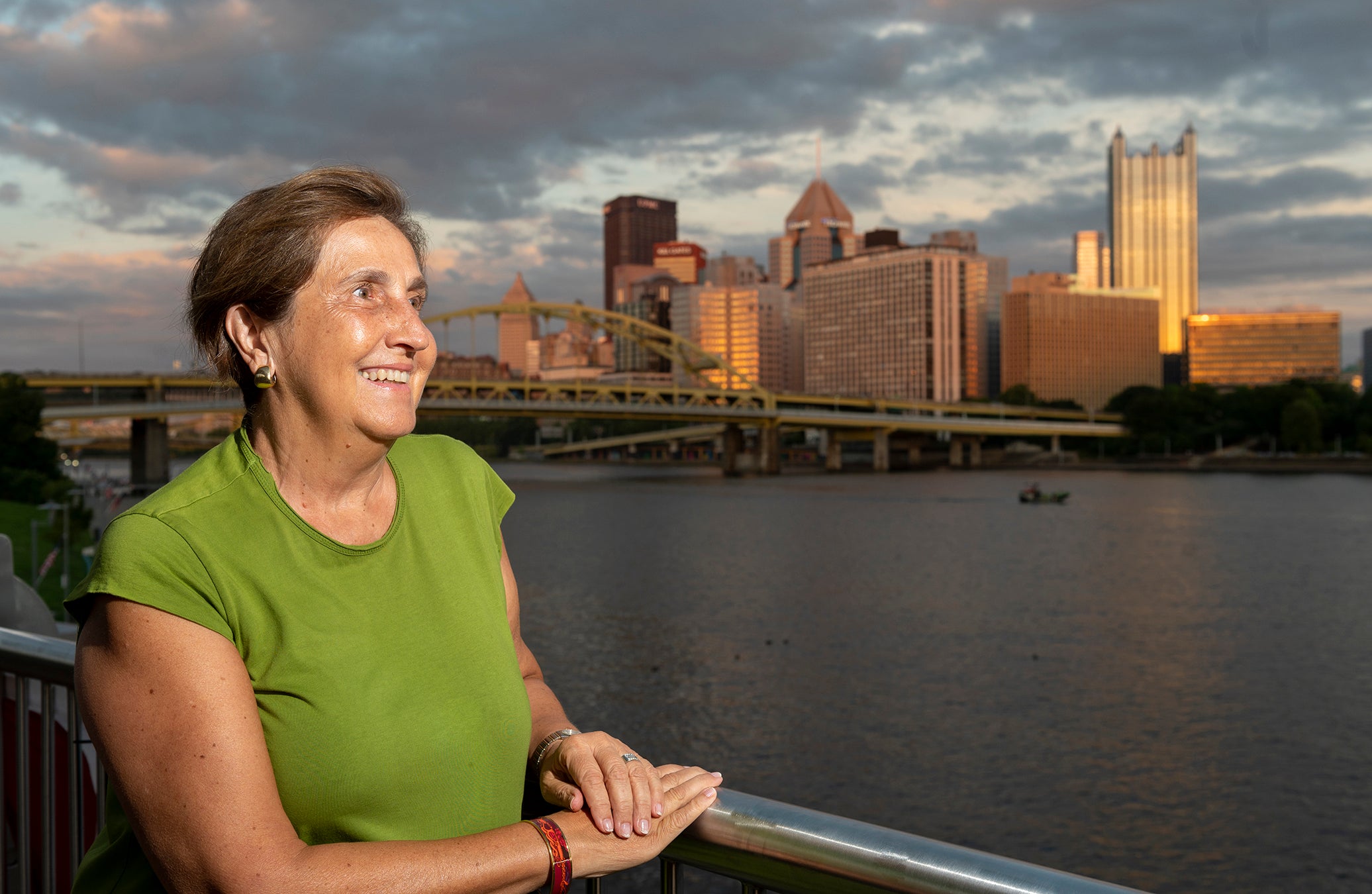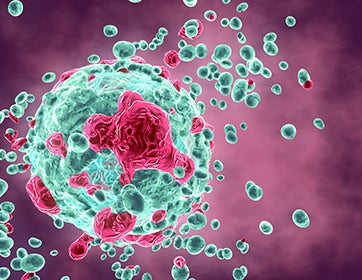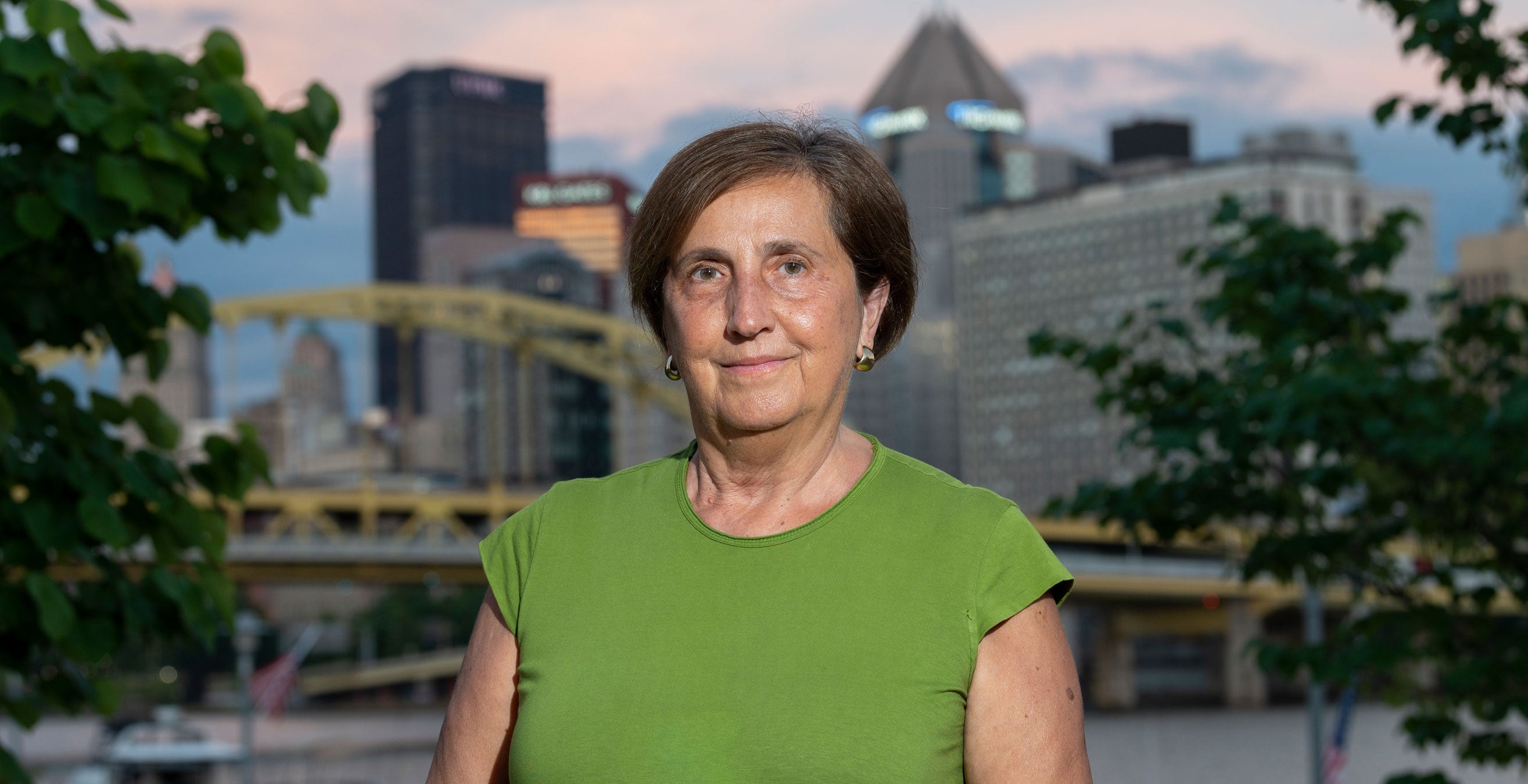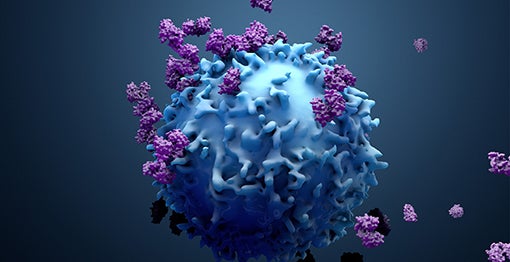
From the riverboat’s deck, Olivera Finn watches with pleasure as downtown Pittsburgh stretches out before her. It’s her first visit, but there’s something about the city that feels familiar. The warmth of the people, the green spaces, the rivers woven into the urban landscape—it’s all reminiscent of Niš, the city in Yugoslavia (now Serbia) where she grew up.
Pittsburgh is certainly different than her current home in North Carolina, where she’s a well-respected immunologist at Duke University. That work is what brought her to the Steel City this June evening in 1990.
She’s here to give a lecture at a conference on transplantation. The organizers arranged sightseeing excursions for the invited speakers, including tonight’s dinner cruise on the Allegheny River.
Finn is leaning on the boat’s railing, taking in the majestic view, when an acquaintance suddenly appears at her side.
“So, Olja, how do you like it?”
It’s Ronald Herberman, an internationally recognized researcher known for his landmark discoveries regarding tumor development and progression—and for building a world-class cancer institute at the University of Pittsburgh.
Finn smiles. She knows that Herberman isn’t here to make small talk. Over the past two years, he’s been trying to convince her to come to Pittsburgh and direct the immunology program at the University of Pittsburgh Cancer Institute (now the UPMC Hillman Cancer Center). He had even wrangled an invitation on this river cruise just to speak with her.
It isn’t the first time he’s suddenly appeared, either. Six months earlier, she had just taken her seat for dinner during an academic conference in Williamsburg, Virginia, when Herberman popped over, snatched up the place card next to her, and replaced it with his own. He had hoped to sway her to come to Pittsburgh during dinner conversation.
She was flattered, she told him then, but she was settled with her family and career in North Carolina.
But Herberman is on the riverboat cruise because he doesn’t want to take no for an answer—and for good reason. Finn is a rising star in cancer-related immunology. In fact, only the year before, in 1989, she published groundbreaking work on an area of research so promising that it has the potential to one day change the landscape of health care itself: the development of a preventative cancer vaccine.
Imagine: a shot that can train the immune system to stop cancer from ever developing. For decades, the concept was seen by many as science fiction. But Finn had hope—and a hypothesis. If there were a way to identify an abnormal cell predisposed to becoming cancerous, then why couldn’t a vaccine be developed to help the immune system target and wipe out those cells?
The findings within her 1989 scientific paper—the one that had Herberman more eager than ever to have Finn continue her efforts at Pitt—had blown the door to a preventative cancer vaccine wide open.
“You know what, Ron?” says Finn, charmed by Pittsburgh’s picturesque views from the riverboat. “I think I’m going to come here and take a look.”
Cancer is a diverse and complex disease. It occurs when genetic mutations cause once-healthy cells to multiply out of control, allowing them to spread through the body like the protruding legs of a crab—which, it’s believed, is how its name was inspired. (Cancer translates to crab in Latin.)
There are more than 100 types of cancer and many more variations of genetic mutations that can cause the disease. The variances are a key reason why developing a cancer vaccine has long been approached as an extremely challenging—perhaps nearly impossible—feat. But that doesn’t mean scientists haven’t been exploring the possibilities.
Over the years, some vaccines have been developed to prevent further growth or reappearance of certain kinds of cancer in those who already have the disease. Preventative cancer vaccines, however, have proven more difficult. Two vaccines currently on the market (the humanpapilloma virus vaccine and the hepatitis B vaccine) don’t stop cancer from developing, but rather prevent the viruses known to cause specific cancers.
have the disease. Preventative cancer vaccines, however, have proven more difficult. Two vaccines currently on the market (the humanpapilloma virus vaccine and the hepatitis B vaccine) don’t stop cancer from developing, but rather prevent the viruses known to cause specific cancers.
Finn, however, has focused her career on developing vaccines for non-viral cancers—and she’s made trailblazing strides.
Even at the start of her career, Finn had imagined a day when people at high risk for cancer could simply receive a preventative vaccine. After earning a doctorate from Stanford University, she took a two-year postdoctoral position working with an advisor researching cancer vaccines. She was fascinated by cancer immunology—the study of how the immune system interacts with cancer cells.
Her interests weren’t always embraced by her colleagues, however.
“Well-meaning people would tell me, ‘Immunology has nothing to do with cancer. If you start your lab in cancer immunology, it will be career suicide,’” says Finn. “And for a few years, I believed them.”
She focused her work instead on organ transplantation immunology.
“But I kept thinking: ‘If the immune system can reject a whole organ, it can reject a cancerous tumor. We just don’t have the targets.’”
The vaccine she envisioned would contain harmless parts of a cancer’s antigen—a substance that can alert the immune system to mount a response. A cancer vaccine using antigens, she believed, would trigger the immune system to fight the often slow-to-develop disease as soon as it first appears, training the body to stop the cancer before it grows.
The problem, however, was that no one had discovered a human tumor-related antigen. So, Finn started searching.
“I believe in tenacity,” she says. “If you really think something is important, stay with it. A lot of time may go by before other people think it’s important; but, if you’re convinced, that’s what you as a scientist have to do, stay with it, and finally prove that it’s important.”
And that’s exactly what she did.
Experiment after experiment, Finn and her team at Duke plugged away, undeterred. Then, in 1988, she had what she calls her “eureka moment.” She was the first to identify a human tumor antigen. It was a protein associated with mucus production which the team named MUC1. Finn’s lab found that tumors express abnormal forms of MUC1—and that when the immune system identified and fought the antigen, the tumor would recede, too.
The discovery suggested that vaccines targeting cancer antigens on precancerous cells could potentially prevent the disease from taking hold.
Finn’s next steps were to create and test a cancer vaccine—work she had already begun.
After taking a closer look at the University of Pittsburgh, she decided it was the place she would continue those efforts.
The city of Pittsburgh may have caught Finn’s attention, but it was something else altogether that made her take a position at Pitt in 1991 and never leave.
“It’s the people at the University,” she says. “At other places during my career, every time I would say, ‘You know what we should do,’ I would get this blank stare from whomever, who would say: ‘We’ve never done that before.’ In Pittsburgh, they would say ‘Whoa! That’s an interesting idea! Let’s try it!’”
Because her research was headed for uncharted waters, Pitt’s scientific culture of curiosity provided just the kind of support she needed.

Persistence and open-mindedness have always been hallmarks of Finn’s life. Growing up in what is now Serbia, she was drawn to languages and theater, but her father—a journalist, who Finn calls “one of my great role models”—insisted that she concentrate on math and science. That’s the kind of knowledge needed for solving problems and making discoveries, he reasoned.
Over the years, she found a passion for the disciplines: “When you’re taught science, it’s facts, and facts always seem dry. Everything else—literature, languages, theater—seems so much more exciting. But,” she explains, “what you don’t know is how addictive it is to actually acquire data and try to interpret it, to design experiments, to learn something new. Until you’re a scientist yourself, you don’t see the excitement.”
The roots of her journey to the United States began to form in the summer of 1966, just before her junior year of high school, when she met Seth Finn, an American college junior on exchange. Immediately smitten, the pair kept in touch after he headed home to finish his degree. He made his way back to her the following year on a Fulbright Fellowship. Headstrong as ever, the young woman married her beau just three days after her 1968 high school graduation. Not everyone was happy about the couple’s decision.
“My parents and in-laws cried together for a while,” she laughs, “but it’s been 54 years, so we were right!”
The newlyweds headed to the United States just as the Vietnam War was escalating, which would interrupt Seth’s plan to pursue a master’s degree in communications research at Stanford University in California. With the military draft looming, he chose to enlist in the Coast Guard. The couple were stationed in Puerto Rico for the next three and a half years. Though she spoke little Spanish, Finn continued her science studies at the local university—after all, she says, science is a “universal language.”
Four years later, after she earned a bachelor’s degree in biology from Interamerican University in San Juan, the couple returned to California, where Finn was accepted to Stanford’s medical microbiology doctoral program. The immunology work unfolding there fascinated her.
“Immunology was a very new discipline. There were only a few centers in the world. That was an exciting time—every day was some new discovery.”
The thrill of discovery followed her to Duke and then to Pitt. Here, in the wake of her cancer antigen breakthrough, she quickly teamed up with Michael Lotze, a surgical oncologist and then codirector of the Pitt Cancer Institute’s biologic therapy program. Their goal: to conduct a human clinical trial of a MUC1 cancer vaccine.
“We were on the front page of the paper, on television,” recalls Finn of the launch of the first trial in 1993. “It was the first vaccine in the world for cancer that was based on a tumor antigen, not on a virus or bacterium.”
 Due to safety regulations from the U.S. Food and Drug Administration, they could only begin a human study with the sickest of subjects. The researchers knew they would likely see only modest responses in that patient group—but it was a first step.
Due to safety regulations from the U.S. Food and Drug Administration, they could only begin a human study with the sickest of subjects. The researchers knew they would likely see only modest responses in that patient group—but it was a first step.
Finn found that her long-held hypothesis was correct—patients did indeed demonstrate a positive immune response to the vaccine. But she and Lotze were also correct in expecting limited effectiveness in the gravely ill. When the vaccine was used therapeutically—to treat existing disease—the immune system was already too suppressed and therefore unable to rebound sufficiently.
The findings, published in 1996, prompted additional National Cancer Institute-funded clinical trials led by Finn throughout the next decade.
Then, in 2008, she collaborated with Robert Schoen, Pitt’s chief of gastroenterology, hepatology and nutrition, to run the first clinical trial of her vaccine as a prophylactic, or preventative, measure.
The goal: to intercept the formation of tumors in cancer-free individuals who were at high-risk for developing the disease. They vaccinated patients who had previously had advanced, pre-cancerous polyps identified and removed during colonoscopy.
In their first study, during which 39 people received a MUC1 vaccine for colon cancer, the researchers confirmed the vaccine’s safety. More excitingly, they reported that 17 patients developed a strong immune response to the cancer antigens. The remaining patients didn’t make antibodies like their counterparts because, Finn found, their immune systems were already suppressed, presumably by the precancerous polyps.
The promising results led to a longer-term, randomized, double-blind trial begun in 2014, also sponsored by the National Cancer Institute. Only 25% of participants developed an immune response to the vaccine, but Finn believes that those numbers could be improved in future studies with the addition of a treatment that combats immune suppression. Of those who developed an immune response to the vaccine, the study showed an encouraging 38% reduction in polyp recurrence.
The results energized Finn and her team—and stood as further proof to the scientist that she’s on the right track.
Today, Finn is a Distinguished Professor of Immunology and Surgery at Pitt. “We built a very strong immunology program and academic department,” she says.
Her efforts have earned her recognition as a trailblazer in cancer immunology, with her MUC1 discovery and subsequent efforts paving the way forward for a generation of cancer and vaccine researchers. The American Association of Immunologists, which has a membership of scientists from all over the world (including 27 Nobel laureates), honored her with its Lifetime Achievement Award in 2016. In the same year, she also received the Outstanding Investigator Award from the National Cancer Institute, which is the federal government’s principal agency for cancer research and training.
The acknowledgments are well deserved, according to her colleagues.
“Dr. Finn has been a pioneer in the use of vaccines in early-stage cancers,” says Patrick Hwu, president of the Society for Immunotherapy of Cancer, a global society of professionals engaged in cancer research and treatment and where Finn was recently inducted as a fellow into the organization’s elite Academy of Immuno-Oncology. “For many years, she has been a champion, leader and mentor in the field of tumor immunology, including the early days when few believed in the potential of harnessing the immune response against cancer.”
And Finn isn’t done yet. She’s poised to start a new trial in conjunction with Leisha Emens, current co-lead of Hillman’s Cancer Immunology and Immunotherapy Program. They will be vaccinating women diagnosed with ductal carcinoma in situ, an early-stage, not-yet-invasive breast cancer.
“The place where vaccines are likely to have their biggest impact is for preventing disease,” says Emens. “That’s where vaccines in general have had a major impact on public health.”
Finn notes that the bulk of cancer immunology resources currently go to immunotherapy—treating existing disease by stimulating the immune system. It’s an area that’s seen rapid advancement and attention in recent years. But, says Finn, although the approach has helped transform care, it has its limitations. Current immunotherapy treatments help about 20% to 30% of patients with only certain cancers, they have side effects, and they can be extremely expensive.
“This is where my background really influences what I do,” she says. “I cannot spend my life developing something that nobody in Niš, Serbia, my hometown, for example, can benefit from. Who’s going to pay $400,000 there for a treatment? We’re still treating just a few people with immunotherapy and only in very highly developed countries.”
Preventative vaccines, on the other hand, promise to be inexpensive and, most significantly, could stop disease before it takes hold. “That’s the ultimate goal,” says Emens. “The holy grail is to keep cancer from happening in the first place.”
Finn highlights the speed of COVID-19 vaccine development, made possible when scientists, government and the pharmaceutical industry pooled their resources. More than 6.5 million have died of COVID-19 worldwide since March 2020, with numbers subsiding thanks to vaccination. But cancer, says Finn, is “an ongoing pandemic claiming 9.5 million lives each year.” A preventative vaccine would be highly consequential.
Progress is indeed being made. Over the course of Finn’s career, she’s seen the medical community fully accept concepts that only decades earlier had been roundly dismissed. Immune-surveillance—or the idea that the immune system continually destroys budding cancer—was a theory once rejected, she points out. Now, the most recent meeting of the American Association for Cancer Research included their first session on precancer and immunoprevention.
Meanwhile, as Science Magazine reported last spring, several new and promising preventative cancer vaccines are in the works around the country. Some of the researchers are building off Finn’s discoveries in ways big and small.
It all keeps Finn’s hope kindled that the kind of cancer vaccine she dreamed of as a postdoc may not be too far away.
“People are coming around to prevention,” she says. “I see a lot more interest, a lot more people talking about it. I believe the time will come when a doctor can identify a patient’s certain cancer risks and then give that patient a preventative vaccine.”
In the meantime, Finn will do what she can to help get us there.
This story is from Pitt Magazine's Fall 2022 issue. It was published on October 10, 2022.
